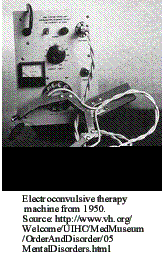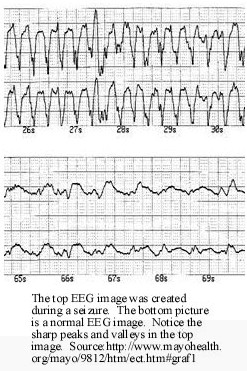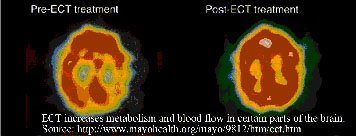Biology 202
2000 Second Web
Report
On Serendip
Electroconvulsive Therapy
Andrew B. Hollander
- By the roots of my hair some god got hold of me.
I sizzled in his blue volts like a desert prophet.
The nights snapped out of sight like a lizard's eyelid:
A world of bald white days in a shadeless socket.
A vulturous boredom pinned me in this tree.
If he were I, he would do what I did. (1).
-Sylvia Plath
"The Hanging Man"
(A poem about her experience with electroshock therapy)
"The Shock Shop, Mr. McMurphy, might be said to do the work of the sleeping pill, the electric chair and the torture rack. It's a clever little procedure, simple, quick, nearly painless it happens so fast, but no one ever wants another one. Ever." (Excerpt from One Flew Over the Cuckoo's Nest, (2)).
The 1962 work, One Flew Over the Cuckoo's Nest, by Ken Kesey, shows the abuse of electroshock therapy to control patients in a mental institution. The 1975 film based on this work undoubtedly left the public with an unfavorable view of electroshock therapy (3). Despite the many critics of this treatment, many medical institutions insist that this therapy is effective and safe. Electroshock therapy, or Electroconvulsive therapy (ECT), is a "medical procedure in which a brief electrical stimulus is used to induce a cerebral seizure under controlled conditions" (4) In this paper I will look at the history of ECT and examine why there is so much controversy surrounding this treatment. Over the decades, electroshock has evolved into an effective treatment, although it is not understood why exactly this treatment works.
In 1934 Von Meduna invented a treatment using insulin to induce seizures in the patient. He based his treatment on studies that suggested a "biological antagonism  between epilepsy and schizophrenia" (4). Technical problems that produced uncomfortable sensations in the patient led to the search for other methods of inducing seizures (4). In 1938 the Italian neurologist Ugo Cerletti and his assistant Lucio Bini developed an alternative method of inducing seizure by using electric shocks (5). Not long after this development, studies showed that ECT was more effective for treating mood disorders such as depression than for treating schizophrenia (4). In the 1940s and 1950s the extensive use of ECT in frequent and high doses for long periods of time produced harmful effects in patients (6). Also, during these years, ECT was used as behavior control of patients in mental institutions (6). During these first years using this treatment, nearly 40% of patients suffered from various complications and the overall mortality rate was 1 in 1,000 (4,6). Despite significant improvements in the treatment, the popularity of ECT in the 1960s and 1970s waned (4). However, starting the in late 1970s, ECT has become more accepted and has been recognized by the APA and NIMH as having important medical value (4).
between epilepsy and schizophrenia" (4). Technical problems that produced uncomfortable sensations in the patient led to the search for other methods of inducing seizures (4). In 1938 the Italian neurologist Ugo Cerletti and his assistant Lucio Bini developed an alternative method of inducing seizure by using electric shocks (5). Not long after this development, studies showed that ECT was more effective for treating mood disorders such as depression than for treating schizophrenia (4). In the 1940s and 1950s the extensive use of ECT in frequent and high doses for long periods of time produced harmful effects in patients (6). Also, during these years, ECT was used as behavior control of patients in mental institutions (6). During these first years using this treatment, nearly 40% of patients suffered from various complications and the overall mortality rate was 1 in 1,000 (4,6). Despite significant improvements in the treatment, the popularity of ECT in the 1960s and 1970s waned (4). However, starting the in late 1970s, ECT has become more accepted and has been recognized by the APA and NIMH as having important medical value (4).
Advances in ECT have made the procedure relatively safe. Recent studies have shown a mortality rate of 2.0 to 4.5 deaths per 100,000 treatments, similar to minor surgery (4). Bone fractures resulting from "spasmodic contraction of the muscles was once a problem," but now a drug called succinycholine is administered to the patient that temporarily paralyzes the muscles so they do not contract and cause fractures (7).  In the past, ECT was administered without anesthesia, but patients today are given a short acting barbiturate (8). Also, an electroencephalogram (EEG) monitors the seizure activity and an electrocardiogram (EKG) monitors the heart rhythm (8). The EEG indicates a series of peaks and valleys during the seizure (9). The seizure appears as a "brief period of muscular rigidity, which is then followed by twitching in the arms, legs, and eyelids" (7). Also, the patient's hands are usually clenched, their toes are pointed, and sometimes their diaphragm heaves (9). There is a complication rate of about 1 in 1,400 (4). These complications include "laryngospasm, circulatory insufficiency, tooth damage, vertebral compression fractures, status epilepticus, peripheral nerve palsy, skin burns, and prolonged apnea" (3).
In the past, ECT was administered without anesthesia, but patients today are given a short acting barbiturate (8). Also, an electroencephalogram (EEG) monitors the seizure activity and an electrocardiogram (EKG) monitors the heart rhythm (8). The EEG indicates a series of peaks and valleys during the seizure (9). The seizure appears as a "brief period of muscular rigidity, which is then followed by twitching in the arms, legs, and eyelids" (7). Also, the patient's hands are usually clenched, their toes are pointed, and sometimes their diaphragm heaves (9). There is a complication rate of about 1 in 1,400 (4). These complications include "laryngospasm, circulatory insufficiency, tooth damage, vertebral compression fractures, status epilepticus, peripheral nerve palsy, skin burns, and prolonged apnea" (3).
The most common side effect of electroconvulsive therapy is memory loss. There are four types of cognitive impairment associated with ECT (4). Immediately following the procedure there is a period of confusion. It can take up to ten minutes for the patient to remember who he or she is and what day it is (10). After the initial confusion, there is a period of retrograde amnesia (4), or forgetting events that happened days, weeks, or months before the treatment (5). The memory loss from electroconvulsive therapy generally follows Ribot's law for all "pathological amnesias: the new dies before the old" (10). This pattern is opposite that of normal forgetting. There is also a period of anterograde amnesia, or forgetting post seizure events (10). Less than one percent of patients experience severe memory loss (8). Studies show that ECT does not permanently affect the ability to learn and remember and ECT does not affect other cognitive abilities (5).
Several factors influence the degree of memory loss. The electrode placement affects memory. Unilateral ECT is the placement of an electrode above the temple on the nondominant side of the brain and another electrode in the middle of the forehead. Bilateral ECT is the placement of an electrode above each temple (8). Studies have shown that unilateral ECT causes less memory loss than bilateral ECT, however bilateral ECT is much more effective (5). There are two types of current that can be used. Sine wave current is correlated with higher memory impairment than is a pulsed current (3). The sine wave current dispenses a significant amount of energy below the patients threshold, thus increasing memory impairment but not enhancing the effects of the procedure" (4). In the early stages of ECT, the sine current was used often, but today the pulse currents are employed. The National Institute of Mental Health recommends that the lowest amount of electricity needed to induce seizure be used (3). The number of treatments also affects memory loss. The way the electroconvulsive therapy affects memory loss is not known. It is hypothesized that "ECT temporarily interrupts protein synthesis and thereby prevents consolidation of what was recently learned and/or alters the neurotransmitter systems related to memory" (5).
Although this therapy has been used since the 1930s, researchers still do not know how ECT works. There are several major theories that attempt to explain why it works. The Neurotransmitter theory suggests that ECT works like anti-depressant medication that changes the way receptors receive mood related chemicals like serotonin (11). The Anti-convulsant theory proposes that the induced seizures "teach the brain to resist seizures. This effort to inhibit seizures  dampens abnormally active brain circuits, stabilizing mood" (11). The Neuroendocrine theory hypothesizes that the "seizure causes the hypothalamus, part of the brain that regulates water balance and body temperature, to release chemicals that cause changes throughout the body" (11). Brain scans have shown that ECT affects the brain by increasing metabolism and blood flow to certain parts of the brain; however, it is not known how this increased blood flow alleviates depression (9). Another theory suggests that this therapy "damages the brain, causing memory loss and disorientation that creates a temporary illusion that problems are gone" (11).
dampens abnormally active brain circuits, stabilizing mood" (11). The Neuroendocrine theory hypothesizes that the "seizure causes the hypothalamus, part of the brain that regulates water balance and body temperature, to release chemicals that cause changes throughout the body" (11). Brain scans have shown that ECT affects the brain by increasing metabolism and blood flow to certain parts of the brain; however, it is not known how this increased blood flow alleviates depression (9). Another theory suggests that this therapy "damages the brain, causing memory loss and disorientation that creates a temporary illusion that problems are gone" (11).
Critics of ECT claim that the procedure damages the brain. An article from 1977 in the American Journal of Psychiatry asserts, "the damaging effects of ECT on the brain are thoroughly documented·there has not been a single detailed report of a normal human brain after shock" (10). However, critics of electroconvulsive therapy often offer results of brain damage tests from the 1940s and 1950s. These statistics are no longer applicable because the safety of the procedure has been increased by better control of the amount of electricity used to initiate the seizure and other medicinal advances that ultimately decrease chances or degree of complications. An article from 1994 in the American Journal of Psychiatry that examined if ECT structurally damages the brain led researches to conclude that there was "no evidence of structural brain damage as a result of ECT" (5). ECT artificially stimulates an epileptical seizure. Seizures produced naturally from epilepsy, unless prolonged or complicated, do not cause brain damage. The artificial seizures are produced under controlled conditions (12). Research using magnetic resonance imaging (MRI) equipment found no change in brain anatomy from ECT (12).
There are several reasons why this treatment is so controversial. Besides the main argument mentioned above, some people may be frightened by the mere language associated with the therapy. The idea of passing electricity through the brain conjures up the image of the electric chair, a punishment reserved for societies most monstrous criminals (5). Another possible reason for some people's strong anti-ECT views may stem from Kesey's work, One Flew Over the Cuckoo's Nest (5). A passage from this piece was quoted earlier in this paper. The work depicts the earlier developments of this treatment and not the ECT of today, or even two decades ago. However, this work left a deep impression on the public that ECT is a painful, humiliating, inhumane procedure used to control unruly patients in mental institutions. The early abuses of electroconvulsive therapy where patients were shocked up to 12 times a day in an effort to regressing the patient to "an infantile state·[to allow] restructuring his or her behavior" (5) undoubtedly left an appalling vision of this therapy in patients and their families. However, this restructuring hypothesis has been abandoned. There is also a small, but vocal group of ECT patients who attack the therapy, perhaps because of feeling violated by the memory loss. Mental illness impairs judgment and it is possible that the patients forgot how sick they were before the treatment (5).
It is understandable how the public can hold such negative views of this treatment. In the early development of ECT, the abuses were terrifying, but technological advances have transformed this once dangerous practice into a treatment that, although not without risk, may improve some people's quality of life and in some case, even save lives. The risks involved with electroconvulsive therapy, such as memory loss, may be more frightening than risks associated with pharmacological treatments; however, when quick improvement must be made, or when other alternatives have failed, electroconvulsive therapy should be considered. The history of this treatment should not condemn it to the annals of failed medical practices, but the current advances in this treatment should earn electroconvulsive therapy the status of a viable treatment option for certain patients.
WWW Sources
1)Electro-Convulsive Treatment in Sylvia Plath's Life and Work, An essay about the influence of ECT experience in Plath's writings
2)Shock treatment therapy, An introduction to a series of articles written in USA Today about ECT
3)Something Shocking, An essay about ECT set in the context of a treatment for depression
4)Electroconvulsive Therapy, The Canadian Psychiatric Association's statement about electroconvulsive therapy
5)Electroconvulsive Therapy: Maligned and Misunderstood, Dr. Rael Jean Isaac offers a brief history of ECT and he attempts to explain the controversy surrounding the treatment
6)Electroconvulsive Therapy, The National Institutes of Health Consensus Development Conference Statement about ECT
7)Electroconvulsive Therapy, This site discusses the pros and cons of the treatment and it outlines the actual procedure
8)All about ECT, Information about ECT posted by the Alliance for the Mentally Ill
9)Electroconvulsive Therapy - Fighting Depression, An overview of ECT from the Mayo clinic
10)Shock Treatment, Brain Damage, and Memory Loss: A Neurological Perspective, A 1977 article in the American Journal of Psychiatry by John M. Friedberg, M.D. This article claims that ECT leads to brain damage
11)How shock therapy works, This USA Today website outlines several theories about how ECT works
12)Electroconvulsive Therapy (ECT), This American Psychiatric Association website offers an explanation about how ECT works, its effectiveness, risks, and dispels myths about ECT related brain damage
 between epilepsy and schizophrenia" (4). Technical problems that produced uncomfortable sensations in the patient led to the search for other methods of inducing seizures (4). In 1938 the Italian neurologist Ugo Cerletti and his assistant Lucio Bini developed an alternative method of inducing seizure by using electric shocks (5). Not long after this development, studies showed that ECT was more effective for treating mood disorders such as depression than for treating schizophrenia (4). In the 1940s and 1950s the extensive use of ECT in frequent and high doses for long periods of time produced harmful effects in patients (6). Also, during these years, ECT was used as behavior control of patients in mental institutions (6). During these first years using this treatment, nearly 40% of patients suffered from various complications and the overall mortality rate was 1 in 1,000 (4,6). Despite significant improvements in the treatment, the popularity of ECT in the 1960s and 1970s waned (4). However, starting the in late 1970s, ECT has become more accepted and has been recognized by the APA and NIMH as having important medical value (4).
between epilepsy and schizophrenia" (4). Technical problems that produced uncomfortable sensations in the patient led to the search for other methods of inducing seizures (4). In 1938 the Italian neurologist Ugo Cerletti and his assistant Lucio Bini developed an alternative method of inducing seizure by using electric shocks (5). Not long after this development, studies showed that ECT was more effective for treating mood disorders such as depression than for treating schizophrenia (4). In the 1940s and 1950s the extensive use of ECT in frequent and high doses for long periods of time produced harmful effects in patients (6). Also, during these years, ECT was used as behavior control of patients in mental institutions (6). During these first years using this treatment, nearly 40% of patients suffered from various complications and the overall mortality rate was 1 in 1,000 (4,6). Despite significant improvements in the treatment, the popularity of ECT in the 1960s and 1970s waned (4). However, starting the in late 1970s, ECT has become more accepted and has been recognized by the APA and NIMH as having important medical value (4). In the past, ECT was administered without anesthesia, but patients today are given a short acting barbiturate
In the past, ECT was administered without anesthesia, but patients today are given a short acting barbiturate  dampens abnormally active brain circuits, stabilizing mood"
dampens abnormally active brain circuits, stabilizing mood"